The current situation of encryption: HODL is dead, DeFi is goodbye, private equity market decline...

Reprinted from panewslab
05/08/2025·17DAuthor: Ignas
Compiled by: Felix, PANews
What changes have happened to cryptocurrencies over the years? Encryption KOL Ignas published an article to sort out this out, believing that HODLing ETH is the biggest mistake it made in this cycle, and “fast in and out” may be the law of crypto profitability, but the only exception to the “fast in and out” strategy is BTC. In addition, in the macro context, the future direction of cryptocurrencies in the new world order is understood. The following are the details of the content.
The reason I love cryptocurrencies and use them as part of finance and trading is because the market will clearly tell you whether it is right or wrong.
Especially in this dystopian world filled with politics, art, news and many other industries, the boundaries between truth and lies are blurred, while cryptocurrencies are straightforward: if you judge correctly, you can make money, and vice versa, you will lose money, which is very simple.
However, the trap that individuals fall into is also simple: when the market situation changes, the portfolio is not re-evaluated. When trading altcoins, you are too conceited about your "HODL (Long-Term Hold)" strategy, especially ETH.
Of course, adapting to new reality is easier said than done.
We need to input too many variables, so we can only end up with a simple strategy like "long-term holding" (HODL) without actively monitoring the market.
But what if the "long-term holding" (HODL) strategy is outdated? What role does cryptocurrency play in a changing world? What else have we overlooked?
In this article, major changes in the market will be shared.
HODL is dead
Time goes back to early 2022:
After a sharp drop in ETH from $4,800, the current trading price is about $3,000. The price of BTC is $42,000. However, both will fall further by 50% due to rate hikes, the collapse of CeFi and the closure of FTX.
Nevertheless, ETH enthusiasts are bullish: ETH is about to move to PoS systems, and just a few months ago, the ETH Destruction Proposal (EIP) was launched. ETH's narrative popularity as an ultrasonic currency and an environmentally friendly and energy-saving blockchain remains unabated.
ETH and BTC did poorly for the rest of 2022, but SOL suffered a heavy blow, plunging 96% to $8.
Ethereum won the competition for Layer1, and the counterfeit Layer1 should be moved to Layer2, otherwise it will face demise.
I remember attending some meetings during the bear market. Most people believe that ETH will rebound the strongest, so they buy ETH in large quantities while underestimating BTC and ignoring SOL.
Just hold it and sell it on top in 2024/2025. Very simple.
But things went against my expectations...
Since then, SOL prices have rebounded, while ETH has suffered the worst FUD ever. Ultrasonic currency narratives are dead (at least for now), and environmental narratives have never really emerged.
For individuals, HODLing ETH is the biggest mistake made in this cycle. The same is true for many people.

The reason for the bullishness at the time was that ETH would become the most valuable asset in crypto history:
Restaking will give ETH super powers, allowing it to not only ensure Ethereum security, but also protect the entire critical DeFi and encryption infrastructure. The (re)staking income of ETH will increase significantly, and as long as ETH is re-staking, the airdrop reward will continue to accumulate.
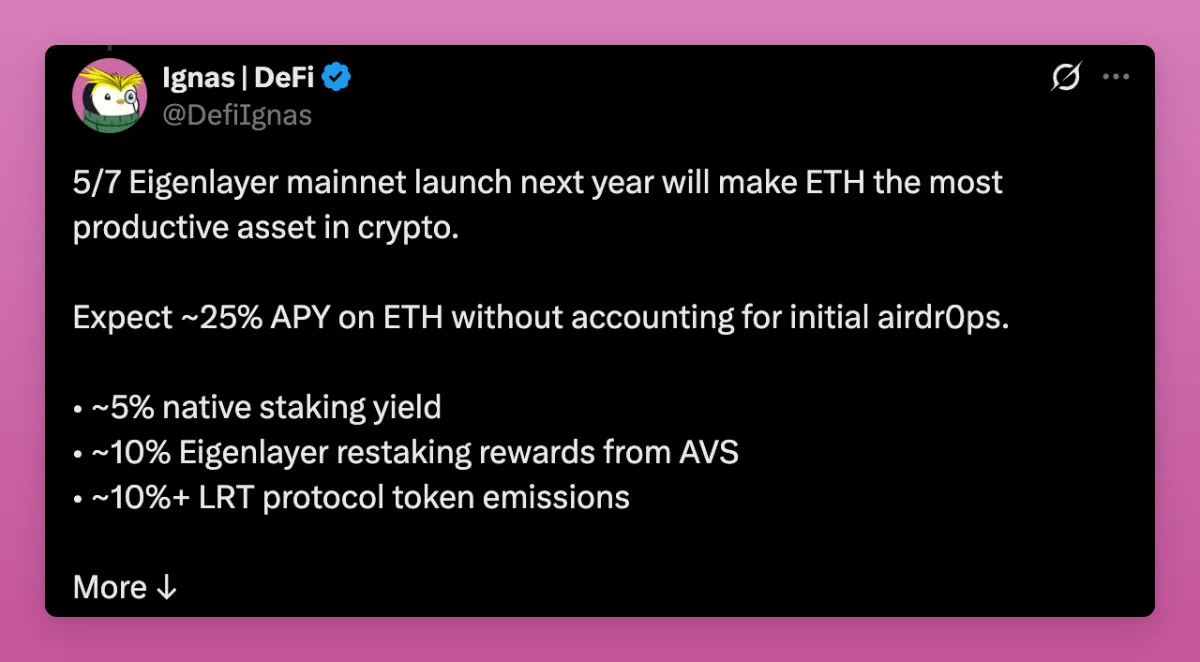
As returns increase, demand for ETH and its price should rise. In short – prices soar!
Obviously, this did not happen because the value proposition of restaking was never clear and Eigenlayer made mistakes in token issuance.
So, how does all this relate to the extinction of the HODL philosophy?
For many people, ETH is an asset that is "holded" and forgotten. If BTC soars, ETH will rise faster, so holding BTC is meaningless.
I should be aware of this and make adjustments when the bullish arguments on ETH based on the restaking narrative fail to be realized. However, I became lazy and complacent, unwilling to admit my mistakes. ETH will rebound one day, doesn’t it?
"Holding" (HODL) is not only a bad advice for ETH, but even more so for all other assets, BTC may be an exception (more on that later).
Cryptocurrencies are changing too quickly and relying on them to support their elderly care for months or years is unrealistic. Looking at the chart, you can see that most altcoins have given up the gains in this bull cycle. Obviously, profit comes from selling, not holding.
The successful memecoin trader explained that he usually doesn't "hoard money" (HODLing) and usually sells memecoin for less than a minute.
Some people still try to peddle you the dream of "hoarding coins" (HODL), but in fact it is more like a "fast in and out" cycle than a long-term holding.

BTC is the only macro crypto asset
The only exception to the “fast in and out” strategy is BTC.
Some people attribute BTC’s outstanding performance to Saylor’s unlimited payouts as we successfully promoted the concept that BTC is digital gold to institutions.
But the battle is not over yet.
Many crypto commentators still view BTC as a risk-favorable asset, saying its trading volatility is higher than the S&P 500 index.
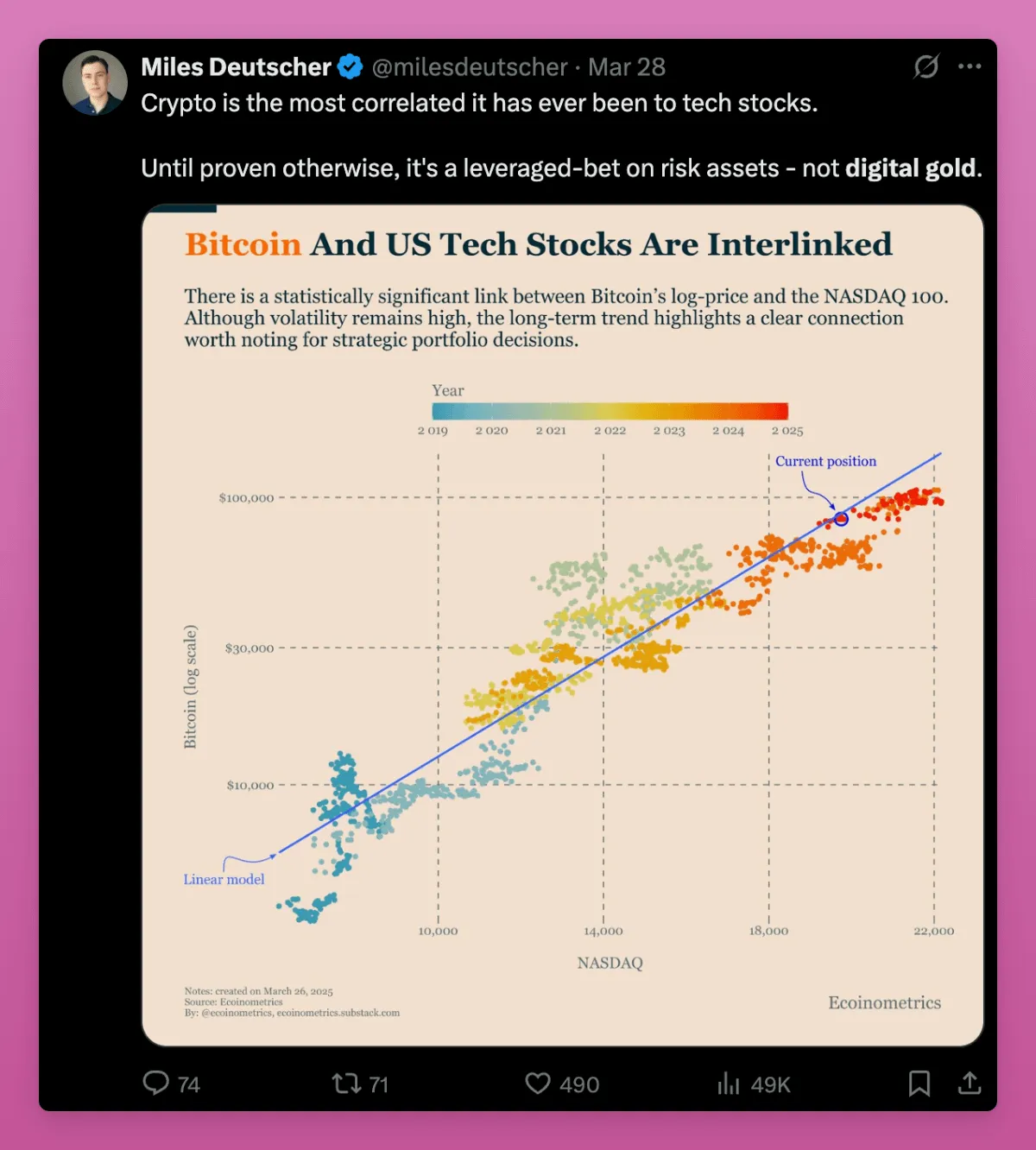
This is contrary to BlackRock's research, which found that the risk and return drivers of BTC are different from traditional risk assets and therefore do not conform to traditional financial frameworks such as "risk preference" and "risk aversion" adopted by some macro commentators.
What do you think is the truth?
Personally, BTC is turning from those who see it as a bet on high leverage stocks to those who see it as a digital safe haven asset similar to gold. A Mexican billionaire Ricardo Salinas, who owns BTC, is an example.
BTC is the only real macro crypto asset. ETH, SOL and other assets are valued based on fees, trading volume and TVL, and BTC has surpassed this framework to become a macro asset recognized by even Peter Schiff.
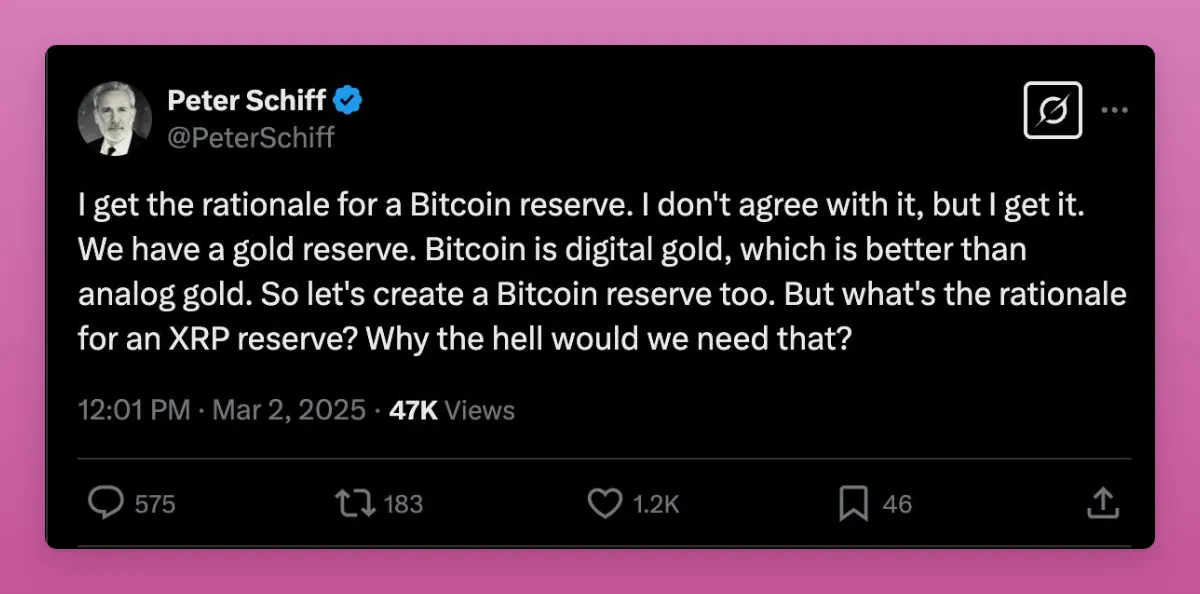
This transformation is not over yet, but this period of transition from risky assets is itself an opportunity. Once BTC is widely regarded as a safe-haven asset, its price will reach $1 million.
The decline of the private equity market
When every relatively successful internet celebrity starts to transform into a "VC", invest at a low price, and then sells and cashes out during the token generation event (TGE), I realize something is wrong.
However, this article by Noah is more reflective of the current situation of the cryptocurrency private equity market.

It is recommended that you read the full text thoroughly, but the following are the key points of the changes in the private equity market over the years.
In the early days (2015-2019), private market participants were true believers. They support Ethereum, fund DeFi pioneer projects like MakerDAO and ETHLend (Aave), and value long-term holdings. Their goal is not just to make quick profits, but to create something meaningful.
This is a stage of believers.
The “Summer of DeFi” from 2020 to 2022 is a huge change. Suddenly, everyone wants to update, more popular tokens. Venture capital institutions have invested money to support tokens with outrageous valuations and no practical value.
The rules of the game are simple: buy at a low price in the private equity round, hype the project, and then sell it to retail investors. When retail investors collapse, we need to clean up and learn from the lessons. But nothing has changed.
This is a greed phase.
After the FTX incident (2023-2025), the private equity market became nihilistic. Venture capitalists are investing in "soulless token machines" (projects with outdated creative ideas, questionable founder background and no practical application scenarios).
The private equity round is priced at 50 times the revenue (if there is income), forcing the open market to bear the losses. As a result, 80% of tokens issued in 2024 fell below private placement prices within six months.
This is an extraction phase.
Today, retail trusts no longer exist, and venture capital companies have suffered heavy losses.
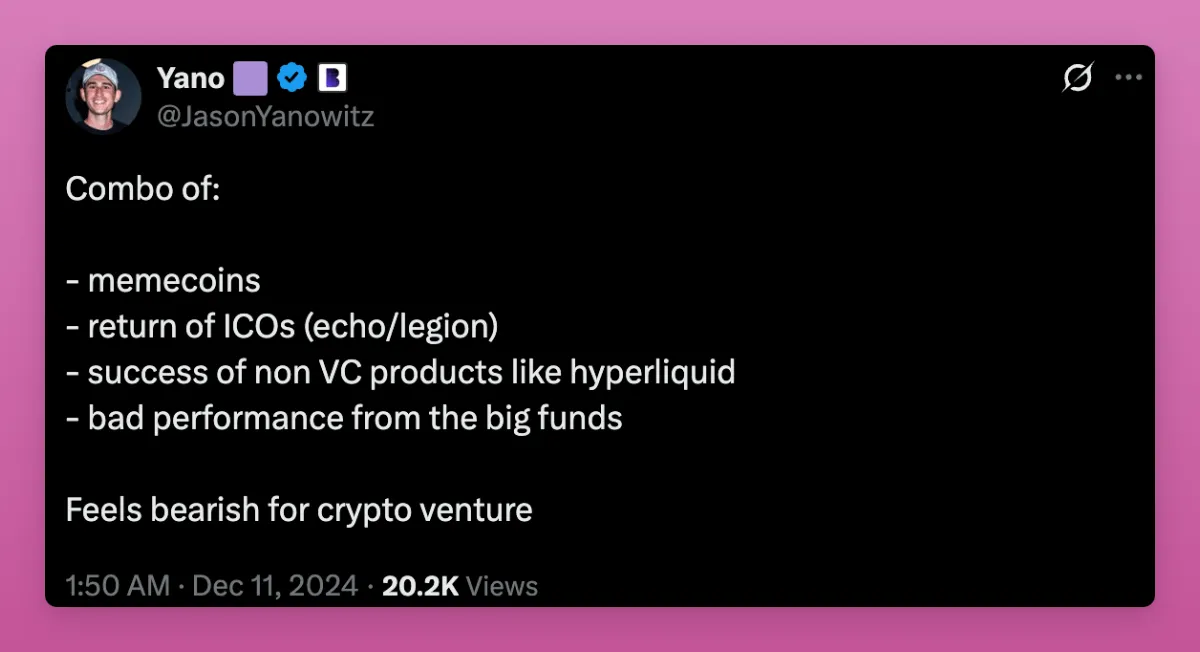
Many venture capital transactions trade at lower prices than they were at the seed round, and some KOL friends are also in a loss-making state.
However, there are also some signs of improvement in the private equity market:
- Movement co-founder and Gabagool (former Aerodrome rugby player) were strongly opposed and expelled. We need further purification.

- Valuations in both private equity and public markets are declining.
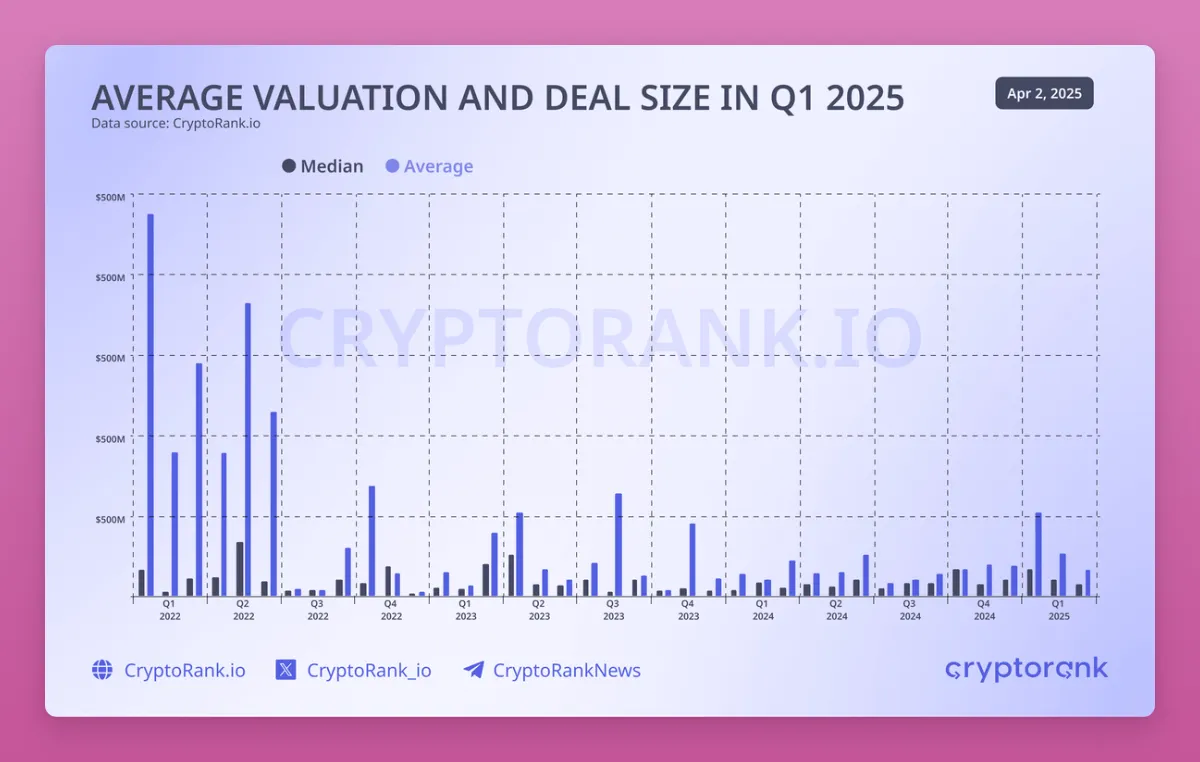
- Crypto Venture Capital has finally recovered, reaching US$4.8 billion in the first quarter of 2025, the highest level since the third quarter of 2022, with funds flowing to areas with practical uses.
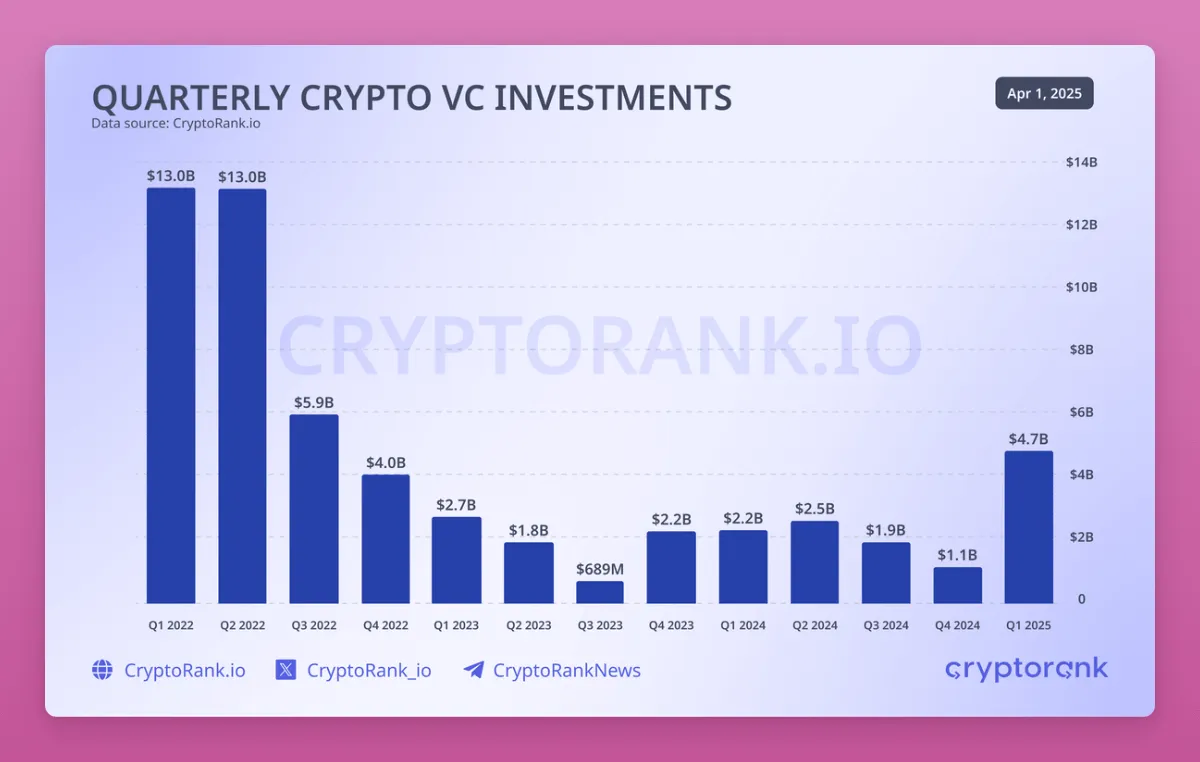
The first quarter of 2025 was the strongest quarter since the third quarter of 2022 . Binance 's $ 2 billion deal played a central role, but another 12 large-scale financings with a scale of more than $ 50 million also indicate that institutional investors ' interest has been rekindled.
Funds flow into areas with practicality and revenue potential, including CeFi , blockchain infrastructure and services. New key areas such as AI , DePIN and RWA have also attracted strong attention. DeFi leads in the number of financing rounds, but the scale of financing is small, reflecting that the valuation is more conservative. ——CryptoRank crypto-sector venture capital status report for the first quarter of 2025
We are trying new token issuance models to reward early supporters rather than insiders.
Echo and Legion are at the forefront, and Base launches a group on the Echo. Kaito's InfoFi (Information Finance) prospects are optimistic because even those who do not have financial capital but have social influence can benefit from it.
The market seems to have received information that the ecosystem is recovering (although KOLs are still taking bonuses).
Say goodbye to DeFi and welcome the financial on-chain
Remember the flash-for-nothing story of Yield Aggregator? Yearn Finance set a precedent, followed by multiple forks.
Now it is in the era of revenue aggregator 2.0. We call it the “Vault strategy.”
As DeFi protocols increase, DeFi becomes more complex, and Vaults are becoming more attractive: depositing assets to obtain the best risk-adjusted returns.
However, the biggest difference between early and current income aggregators is the increasing centralization of asset management.
Vault has “Strategists” – usually a team of “institutional investors” who will use your money to chase the best investment opportunities. For them, it's a win-win: They use your funds and earn fees from them.
These strategists include MEV Capital, Seven Seas, Gauntlet, Veda, and many companies that work with agreements such as Etherfi, Upshift and Mellow Protocol.
Veda itself is the 17th largest "protocol" in DeFi, surpassing Curve, Pancakeswap or Compound Finance.
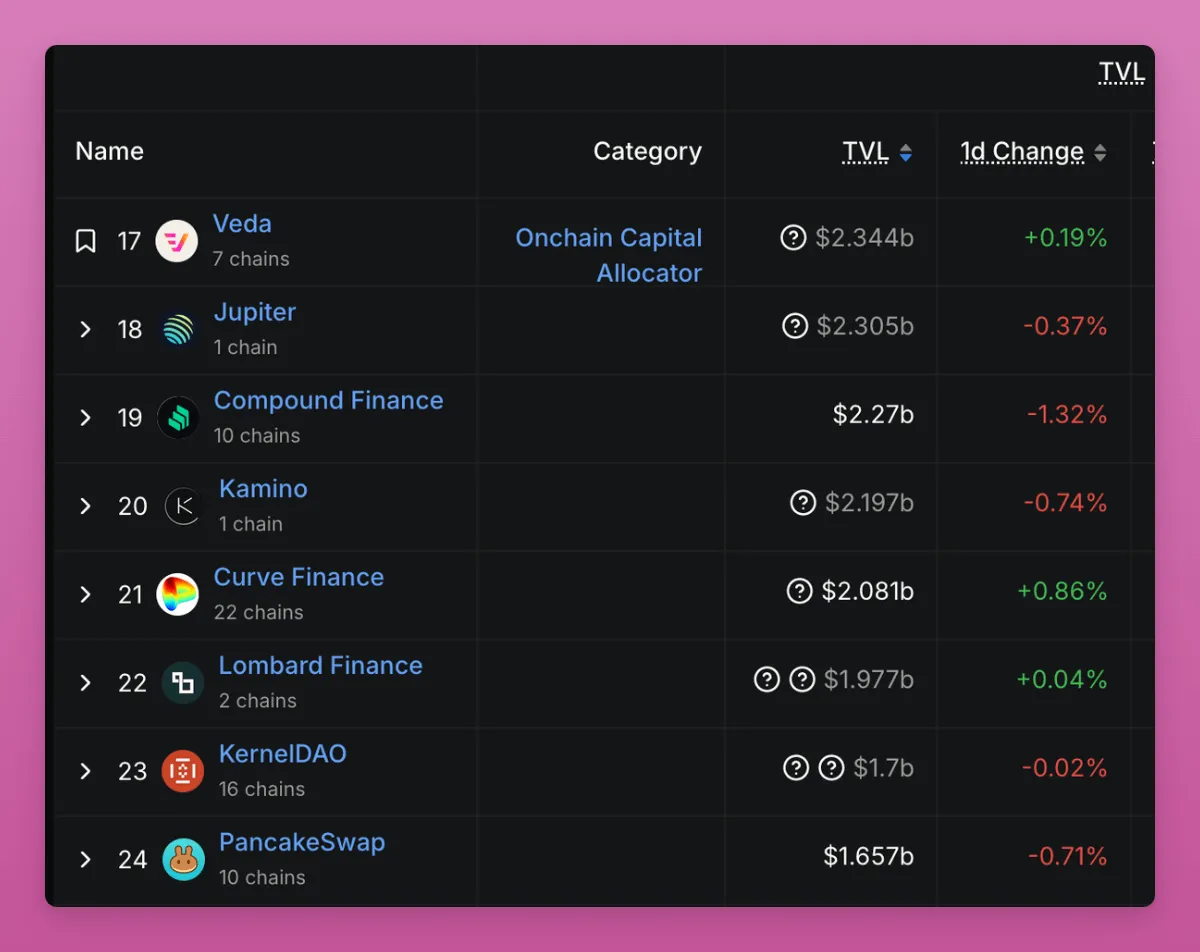
However, Vault is just the tip of the iceberg. DeFi's true decentralization vision has long been shattered; it has evolved into on-chain finance.
Think about it: the fastest-growing RWA in DeFi and crypto, the profit-making stablecoins like Ethena, BlackRock's BUIDL, and Delta-neutral stablecoins are far from DeFi's original vision.
Or multi-signature contracts like BTCfi (and BTC L2s), you have to trust the custodian to not take away your funds.
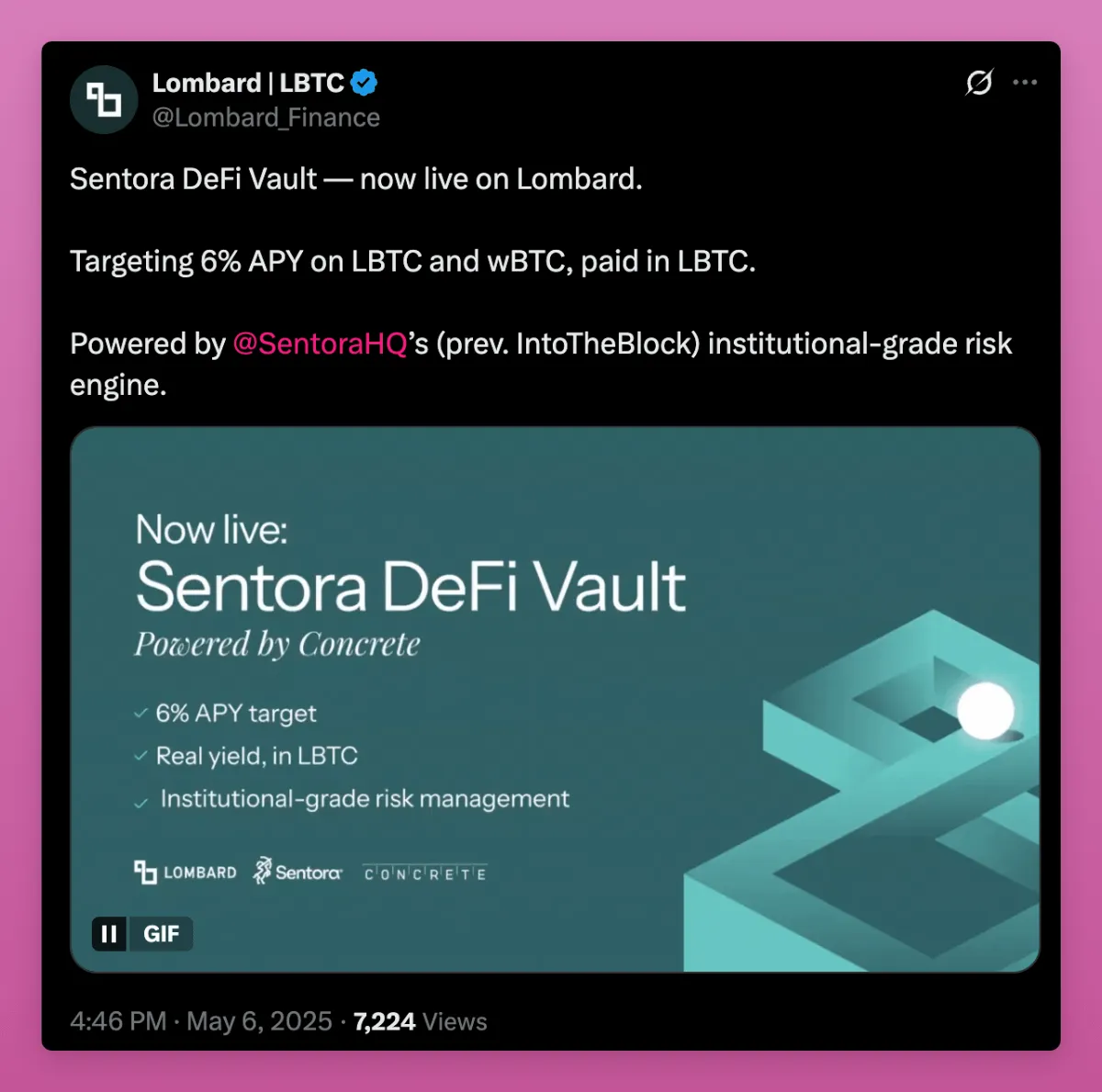
_Note:_ There is no point _in_ _Lombard_ _here_ _, just as_ _an example of_ _Vault \'s_ fusion _with_ _BTCfi_ trends
This has been the case since Maker moved from decentralized DAI to earnings-generated RWA protocols. True decentralized protocols are few and small in scale (Liquity is an example).
This isn't necessarily a bad thing: RWA and tokenization allow us to get out of the cyclical, leveraged-based era of DeFi Ponzi schemes.
This means that risk factors are expanding, making it more complicated to understand where the funds are going. Don't be surprised if you see the CeDeFi protocol abuse user funds.
Remember: Hidden levers always find ways to penetrate the system.
DAO is dead in name only
The same decentralized fantasy is shattering in DAO.
The past philosophy is based on the “gradual decentralization” theory promoted by a16z in January 2020.
The protocol first finds PMF (product market fit) → As the network effect grows, the community gains more power → The team "quits the community" and ultimately achieves full decentralization.
Five years have passed and we are returning to centralization. Take the Ethereum Foundation as an example, it is stepping in more actively to expand the scale of L1. The DAO model faces many problems:
- Voters' indifference
- Risk of lobbying (election bribery) is increasing
- Execution paralysis
Arbitrum and Lido are two DAOs that are moving towards more centralized control (through more active team engagement or BORGs), but Uniswap is undergoing a major change.
The Uniswap Foundation votes to provide $165 million in liquidity mining rewards to drive the growth of Uniswap v4 and Unichain. Or another conspiracy theory says it is to meet the liquidity threshold required to receive Optimism OP funding rewards.
Anyway, the DAO delegates were angry. Why does the foundation pay all $UNI rewards while Uniswap Labs (centralized entities) earn millions of dollars from the Uniswap front-end?
A top 20 representative recently resigned from Uni representative.
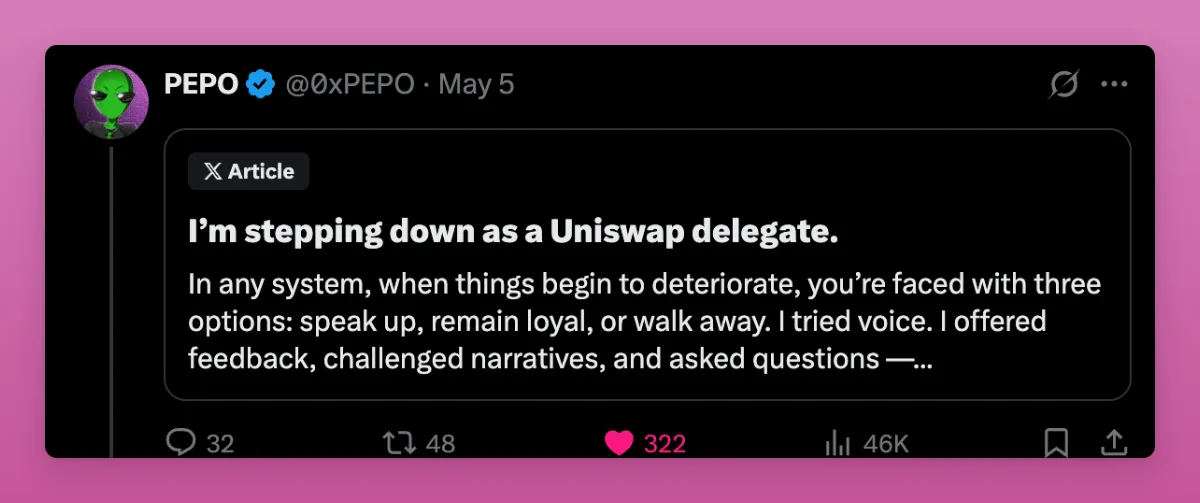
It is recommended to read this article in full, but his views are as follows:
- Governance show: Uniswap's DAO seems open, but in fact it is marginalized opposition. Proposals follow the process (discussion, vote, forum), but feel like they are pre-decided, reducing governance into a kind of "ritual".
- Concentration of power: Uniswap Foundation rewards loyalty, suppresses criticism, and values superficial image more than responsibility.
- Failure of decentralization: If DAO prioritizes brand building over substance, it may become irrelevant. If a real responsibility mechanism is lacking, it will become a "diplomatic dictatorship".
Interestingly, a16z is the main token holder of Uniswap, but Uniswap is far from real decentralization.

Perhaps it is not an exaggeration to say that DAO is just a cover; we need a coherent story to circumvent the regulatory scrutiny that centralized cryptocurrency companies may face.
Therefore, tokens that are just voting tools are no longer worth investing. True profit sharing and practicality are the key.
DEX ( Hyperliquid ) Challenge CEX
Now, share my conspiracy theory.
FTX launched Sushiswap because they fear Uniswap might seize its spot market. Even if they did not launch directly, they were likely to have given close support in terms of development and funding.
Similarly, the Binance team (or BNB, whatever you want) launched PancakeSwap for the same reason.
Uniswap has posed a major threat to CEX, but this threat has been largely resolved because Uniswap does not pose a challenge to their more profitable perpetual contract trading business.
How big is the profit? As can be seen from the comments, it is hard to say.
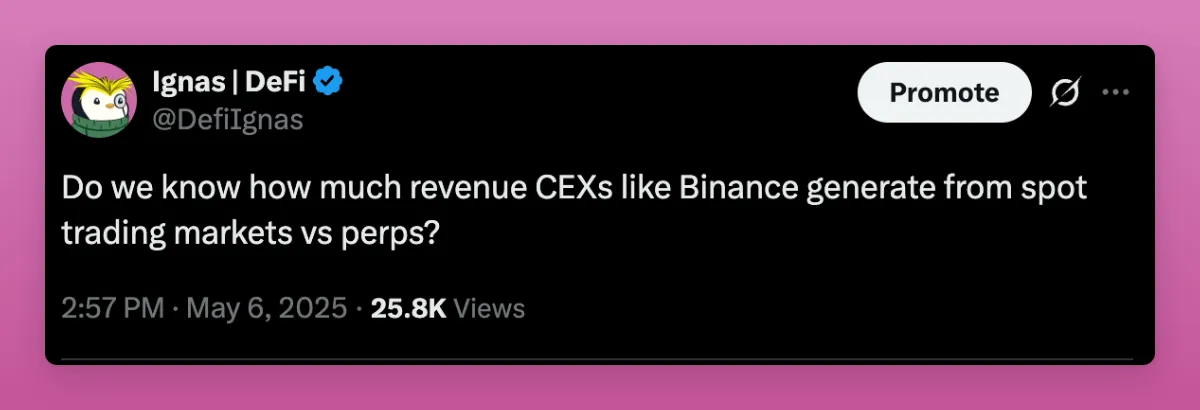
Hyperliquid presents another threat. It not only delves into the perpetual contract business, but also aims at the spot market. At the same time, it is also building its own smart contract platform.
Hyperliquid's share in the perpetual contract market has grown to 12.5%. (Real-time statistics can be viewed here or here .)
I was shocked to see Binance and OKX openly attacking Hyperliquid with JELLYJELLY. Although Hyperliquid survived, investors in HYPE must now take the risk of potential attacks in the future very seriously.
This may not be a similar attack, but regulatory pressure, as CZ is becoming a “strategic crypto consultant at the national level.” What do you think he will say to politicians? Oh, those crime exchanges that don't do KYC are so bad, maybe?
In any case, I hope Hyperliquid can surpass the CEX spot market business and launch a more transparent coin listing service that will not collapse the financial situation of the agreement.
There is still a lot to say about HYPE, because it is the largest altcoin position that an individual holds. But Hyperliquid has become a campaign to challenge CEX, especially after the Binance/OKX attack.
Agreement → Platform
You may have seen my euphemistic recommendations for Fluid in the context of the protocol evolved into a platform. The point is that protocols have the risk of becoming commercial infrastructure, while user-facing applications reap most of the benefits.
Is Ethereum falling into the commodity trap?
To get rid of this dilemma, the protocol needs to become like the Apple Store, allowing third-party developers to develop on it so that value can remain in the entire ecosystem.
Uniswap v4 and Fluid are trying to achieve this with Hooks, while teams like 1inch and Jupiter have built their own mobile wallets. LayerZero has just announced vApps.
This trend will accelerate. Those who can capture liquidity, attract users and find ways to monetize liquidity while rewarding token holders will be the biggest winners.
Cryptocurrencies in a changing world order
I want to explore more major changes in the crypto space, from stablecoins to CT (crypto Twitter) that has become increasingly blurred as cryptocurrencies become increasingly complex.
As the crypto industry is no longer as closed as it used to be, Twitter now offers less exclusive news.
Previously, we were able to launch a Ponzi scheme with simple rules of the game, and regulators either misunderstand cryptocurrencies or ignore them in the hope that it will disappear on its own.
Year after year, discussions about regulation are becoming more common in CT. Fortunately, the United States is gradually supporting cryptocurrencies, and it seems that large-scale adoption is coming soon as stablecoins, tokenization and Bitcoin become a means of store of value.
But that may change soon: the U.S. government may eventually realize that Bitcoin is indeed weakening the dollar's status.
Outside the United States, regulatory and cultural environments are very different. China currently shows no sign of supporting cryptocurrencies.
The EU is increasingly focusing on control, especially as it moves from welfare states to war states, where controversial decisions may be forced into the name of "safety".
Instead of prioritizing cryptocurrencies, the EU sees them as a threat:
- ECB warns U.S. push for cryptocurrencies could trigger financial spread
- The EU will ban anonymous cryptocurrency accounts and privacy coins in 2027.
- If the blockchain data cannot be deleted separately, "this may require deleting the entire blockchain."
- EU regulators to create punitive capital regulations for insurance companies holding cryptocurrencies
We need to evaluate the attitudes towards cryptocurrencies under the current overall political situation. The general trend is de-globalization and the closure of entry and exit doors among countries.
- The EU is about to impose a visa-free ban on citizens of investment countries.
- European Court of Justice suspends "Golden Visa" plan
The biggest unknown is what role cryptocurrencies will play in the new world order and during the transition period.
Will cryptocurrencies become tools of capital freedom, especially as capital controls begin to be implemented? Or are Congresses trying to suppress cryptocurrencies by enacting increasingly strict regulations?
Vitalik explains in his article “The Year Ring Model of Culture and Politics” that cryptocurrencies are still forming their norms and are not as established as banking laws or intellectual property laws.
The Internet in the 1990s adhered to the concept of "let it develop!", with almost no rules and high freedom. By the early 2000s and 1910s, attitudes towards social media changed to “This is dangerous. To control it!” And into the 2020s, cryptocurrencies and artificial intelligence are still struggling between openness and regulation.
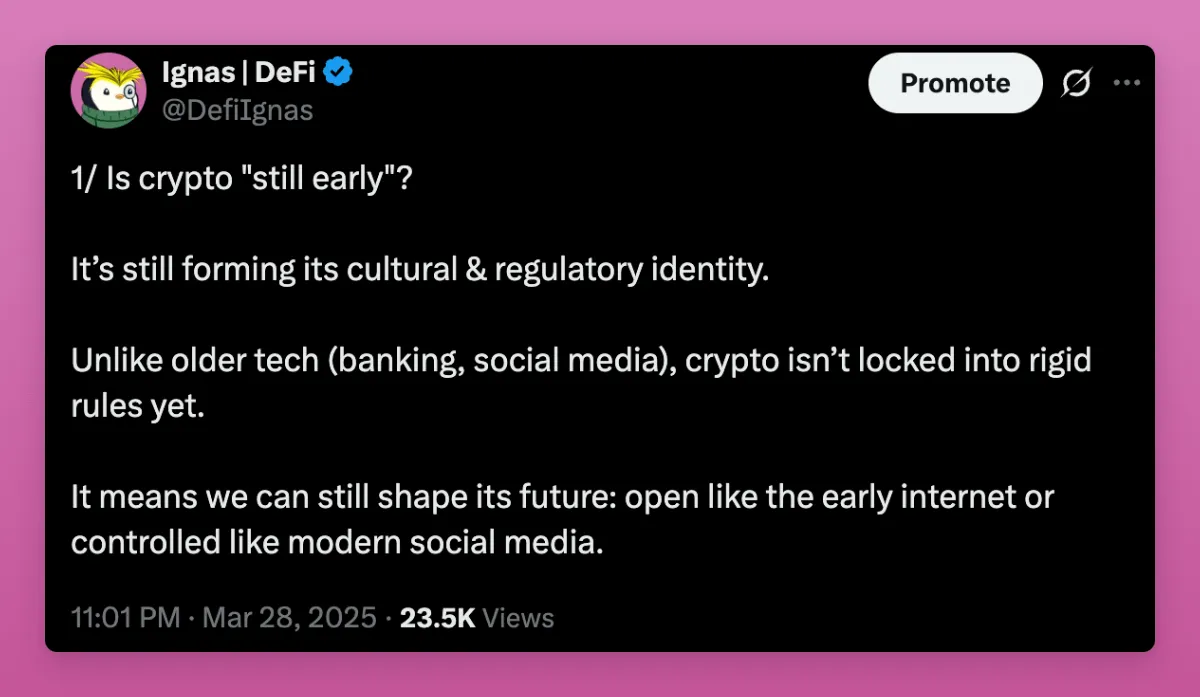
The government used to be slow to move, but is now catching up.
Hopefully they choose to embrace openness, however, the global trend of border blockades is very worrying.
Related Reading: Dialogue Arthur Hayes: Sino-US trade war is a long-term trend, and Bitcoin will exceed $1 million by 2028



 jinse
jinse